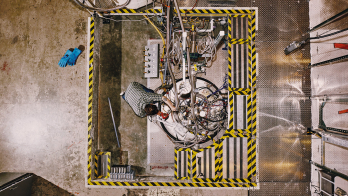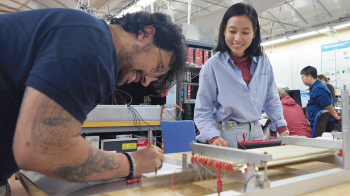
One hundred and fifty years since Dmitri Mendeleev revolutionised chemistry with the periodic table of the elements, an international team of researchers has resolved a longstanding question about one of its more mysterious regions – the actinide series (or actinoids, as adopted by the International Union of Pure and Applied Chemistry, IUPAC).
The periodic table’s neat arrangement of rows, columns and groups is a consequence of the electronic structures of the chemical elements. The actinide series has long been identified as a group of heavy elements starting with atomic number Z = 89 (actinium) and extending up to Z = 103 (lawrencium), each of which is characterised by a stabilised 7s2 outer electron shell. But the electron configurations of the heaviest elements of this sequence, from Z = 100 (fermium) onwards, have been difficult to measure, preventing confirmation of the series. The reason for the difficulty is that elements heavier than fermium can be produced only one atom at a time in nuclear reactions at heavy-ion accelerators.
Confirmation
Now, Tetsuya Sato at the Japan Atomic Energy Agency (JAEA) and colleagues have used a surface ion source and isotope mass-separation technique at the tandem accelerator facility at JAEA in Tokai to show that the actinide series ends with lawrencium. “This result, which would confirm the present representation of the actinide series in the periodic table, is a serious input to the IUPAC working group, which is evaluating if lawrencium is indeed the last actinide,” says team member Thierry Stora of CERN.
Using the same technique, Sato and co-workers measured the first ionisation potential of lawrencium back in 2015. Since this is the energy required to remove the most weakly bound electron from a neutral atom and is a fundamental property of every chemical element, it was a key step towards mapping lawrencium’s electron configuration. The result suggested that lawrencium has the lowest first ionisation potential of all actinides, as expected owing to its weakly bound electron in the 7p1/2 valence orbital. But with only this value the team couldn’t confirm the expected increase of the ionisation values of the heavy actinides up to nobelium (Z = 102). This occurs with the filling of the 5f electron shell in a manner similar to the filling of the 4f electron shell until ytterbium in the lanthanides.
In their latest study, Sato and colleagues have determined the successive first ionisation potentials from fermium to lawrencium, which is essential to confirm the filling of the 5f shell in the heavy actinides (see figure). The results agree well with those predicted by state-of-the-art relativistic calculations in the framework of QED and confirm that the ionisation values of the heavy actinides increase up to nobelium, while that of lawrencium is the lowest among the series.
The results demonstrate that the 5f orbital is fully filled at nobelium (with the [Rn] 5f14 7s2 electron configuration, where [Rn] is the radon configuration) and that lawrencium has a weakly bound electron, confirming that the actinides end with lawrencium. The nobelium measurement also agrees well with laser spectroscopy measurements made at the GSI Helmholtz Center for Heavy Ion Research in Darmstadt, Germany.
“The experiments conducted by Sato et al. constitute an outstanding piece of work at the top level of science,” says Andreas Türler, a chemist from the University of Bern, Switzerland. “As the authors state, these measurements provide unequivocal proof that the actinide series ends with lawrencium (Z = 103), as the filling of the 5f orbital proceeds in a very similar way to lanthanides, where the 4f orbital is filled. I am already eagerly looking forward to an experimental determination of the ionisation potential of rutherfordium (Z = 104) using the same experimental approach.”
Further reading
T Sato et al. 2015 Nature 520 209.
T Sato et al. 2018 J. Am. Chem. Soc. 140 14609.
P Chhetri et al. 2018 Phys. Rev. Lett. 120 263003.







